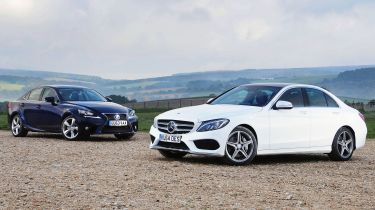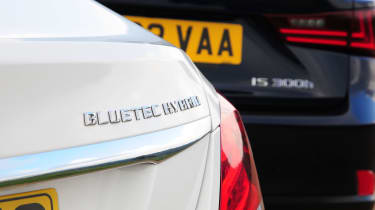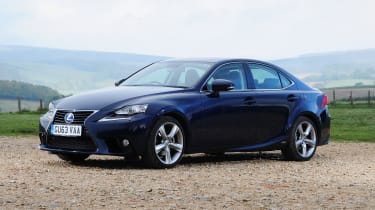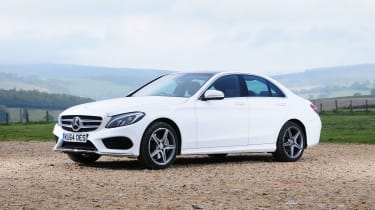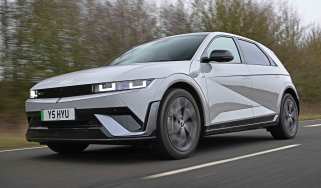Mercedes C300 BlueTEC Hybrid vs Lexus IS 300h
Mercedes promises to mix luxury and efficiency with its new hybrid C-Class - here it takes on the Lexus IS 300h
As car makers continue to search for the Holy Grail of ever-greater efficiency without sacrificing performance, more brands are investing in hybrid technology to deliver the best combination of mpg and mph.
Mercedes has offered hybrid drive on the S-Class limo and E-Class executive for a while, but now the new C-Class benefits from the same technology. The C300 BlueTEC Hybrid combines the firm’s tried-and-tested 2.1-litre diesel with an electric motor, and promises economy of up to 78mpg.
Of course, Toyota has long established itself as a hybrid pioneer, and premium division Lexus has foregone diesel power completely in favour of petrol-electric hybrids. For this test, we’ve lined up the IS 300h, which claims to return 60.1mpg, while top-spec versions come loaded with standard kit. Can the hybrid Merc make an impact – or does the Lexus still lead the electric charge?
Follow the links above to see full tests of each car, and scroll down to find out the verdict of this hybrid twin-test...
Head-to-head
Hybrid systems
The biggest difference between these cars is that the Mercedes is a diesel-electric hybrid, compared to petrol-electric for the Lexus.
Used - available now

2019 Mercedes
C Class
31,081 milesAutomaticDiesel1.6L
Cash £20,900
2019 Mercedes
C Class
60,818 milesAutomaticDiesel2.0L
Cash £19,387
2021 Mercedes
C Class
51,520 milesAutomaticDiesel2.0L
Cash £20,995
2021 Mercedes
C Class
34,712 milesAutomaticDiesel2.0L
Cash £20,187In normal driving it’s clear the C300 relies on its engine most of the time, and uses the electric motor for a power boost. In contrast, the IS 300h wants to run in electric mode as often as possible, and with the engine only running full-time when you’re at speed – although this does harm economy.
Energy monitor
There are few clues to the C300 BlueTEC’s hybrid drive inside. While there’s an energy gauge in the bottom of the speedo, it can be easily obscured if you set the wheel high. The Lexus’ energy gauge is next to the speedo, but it’s replaced by a rev counter when you switch to sport mode.
Options
The Lexus’ limited options include metallic paint (£610), a sunroof (£1,000), different wheels (£1,995) and Advanced Safety Pack (£1,540). The Merc has a lot more options, in packs. Ours had £10,000-worth, including the £2,795 Premium Plus pack with panoramic roof, high-end audio, electric seats and more.
Verdict
1st place: Lexus IS 300h
In the battle of the hybrid saloons, the IS 300h takes a narrow win. Its hybrid powertrain feels better resolved than the Mercedes’, as it relies on the electric motor more frequently to save fuel, is more refined and switches between drive modes more smoothly. The Lexus isn’t as fast as its rival, but it’s more relaxing to drive, and while it trails on interior quality, if you go for a Premier model, you won’t be left wanting for kit.
2nd place: Mercedes C300 Hybrid
The C-Class feels like a shrunken S-Class inside, but if you buy a BlueTEC Hybrid for its fuel-saving potential, you might be disappointed. It runs on its noisy diesel too often, spoiling the cabin ambience and harming economy, while the car never feels as relaxing as the IS on the road. There’s lots of kit, but apart from the C300’s added performance and low emissions, it doesn’t deliver much more over a standard diesel C-Class.
Hybrid compact executives: key specs
| Lexus IS 300h Premier | Mercedes C300 BlueTEC Hybrid AMG Line | |
| On the road price/total as tested | £38,495/£39,105 | £38,120/£46,015 |
| Residual value (after 3yrs/36,000) | £17,015/44.2% | TBC |
| Depreciation | £21,480 | TBC |
| Annual tax liability std/higher rate | £1,076/£2,153 | £914/£1,827 |
| Annual fuel cost (12k/20k miles) | £1,506/£2,509 | £1,663/£2,772 |
| Ins. group/quote/road tax band/cost | 33/£418/B/£20 | 37/£436/A/£0 |
| Cost of 1st/2nd/3rd service | £773 (3yrs) | £425 (5yrs) |
| Length/wheelbase | 4,665/2,800mm | 4,686/2,840mm |
| Height/width | 1,430/1,810mm | 1,442/1,810mm |
| Engine | 4cyl in-line/2,494cc | 4cyl in-line/2,143cc |
| Peak power/revs | 220/6,000 bhp/rpm | 228/3,800 bhp/rpm |
| Peak torque/revs | 221/4,200 Nm/rpm | 500/1,600 Nm/rpm |
| Transmission | e-CVT/rwd | 7-spd auto/rwd |
| Fuel tank capacity/spare wheel | 66 litres/repair kit | 50 litres/run-flats |
| Boot capacity | 450 litres | 480 litres |
| Kerbweight/payload/towing weight | 1,620/525/750kg | 1,715/480/1,600kg |
| Turning circle | 11.0 metres | 11.2 metres |
| Basic warranty (miles)/recovery | 3yrs (unlimited)/3yrs | 3yrs (unlimited)/4yrs |
| Service intervals/UK dealers | 10,000 miles (1yr)/51 | Variable/136 |
| Driver Power manufacturer/dealer pos. | 4th/1st | 9th/21st |
| Euro NCAP: Adult/child/ped./stars | 91/85/80/5 | 92/84/77/5 |
| 0-60/30-70mph | 7.8/7.1 secs | 6.5/6.0 secs |
| 30-50mph in kickdown | 3.0 secs | 2.4 secs |
| 50-70mph in kickdown | 4.3 secs | 3.5 secs |
| Top speed/rpm at 70mph | 125mph/1,200rpm | 152mph/1,600rpm |
| Braking 70-0/60-0/30-0mph | 51.0/36.7/9.2m | 46.7/33.3/8.9m |
| Noise outside/idle/30/70mph | 66/49/52/63dB | 71/48/63/71dB |
| Auto Express econ (mpg/mpl)/range | 45.8/10.1/665 miles | 42.8/9.4/471 miles |
| Govt urban/extra-urban/combined | 57.6/57.6/60.1mpg | 72.4/83.1/78.5mpg |
| Govt urban/extra-urban/combined | 12.7/12.7/13.2mpl | 15.9/18.3/17.3mpl |
| Actual/claimed CO2/tax bracket | 142/109g/km/14% | 177/99g/km/12% |
| Airbags/Isofix/park sensors/camera | Seven/yes/yes/yes | Eight/yes/yes/yes |
| Auto box/stability/adaptive cruise ctrl | Yes/yes/£1,540 | Yes/yes/£1,495 |
| Climate control/leather/climate seats | Yes/yes/yes | Yes/yes/heated |
| Metallic paint/LED lights/keyless go | £610/xenons/yes | £645/yes/£1,595 |
| Sat-nav/USB/DAB radio/Bluetooth | Yes/two/yes/yes | Yes/two/yes/yes |
